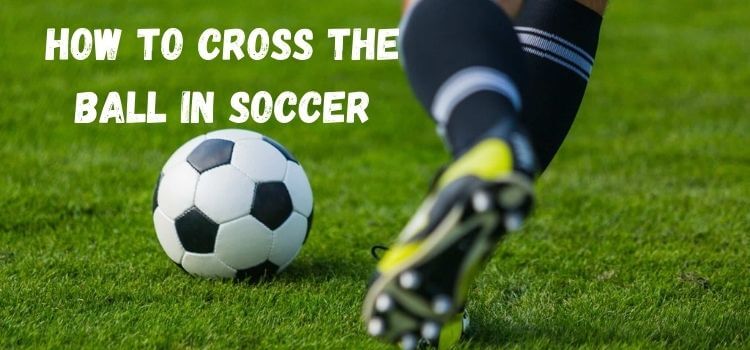As an Amazon Associate, I earn from qualifying purchases
A soccer player’s ability to cross the ball is a skill that can rapidly change the course of a game. A well-executed cross can split defenses, create goal-scoring opportunities, and elevate a team’s offensive prowess. Whether you’re a winger aiming to deliver pinpoint assists or a full-back looking to add an extra dimension to your game, mastering the cross is essential. In this article, we’ll explore the nuances of crossing the ball in soccer, studying techniques, tips, and drills to help you cross like a pro.

Understanding the Basics of Crossing
What is a Cross in Soccer?
The goal of a cross in soccer is to reach a teammate in a scoring position by making a medium- to long-range pass the ball from a broad section of the field toward the center. It’s typically delivered into the opponent’s penalty area to set up a goal.
Types of Crosses
Crosses come in various forms, each serving a specific purpose:
- In-Swinging Cross: Curves towards the goal.
- Out-Swinging Cross: Curves away from the goal.
- Low Cross: Delivered close to the ground.
- High Cross: Lofted into the air.
Why Crossing is Essential in Soccer
Creating Goal-Scoring Opportunities
Crossing opens up multiple avenues for creating goal-scoring chances. Players can set up teammates for headers, volleys, or simple tap-ins by delivering the ball into dangerous areas.
Stretching the Defense
Influential crossing forces the opposing defense to spread out, creating gaps and disrupting their formation. This defense stretching can lead to more space for attacking players to exploit.
Key Elements of a Successful Cross
Accuracy
Accuracy is paramount. A well-placed cross can differentiate between a scoring chance and a wasted opportunity. Focus on hitting your target consistently.
Timing
The timing of your cross is crucial. Deliver the ball too early or too late, and you miss the opportunity. Coordinate with your teammates to ensure synchronization.
Power
Adjust the power of your cross based on the situation. A driven cross requires more force, while a lofted cross needs a delicate touch.
Vision
Vision enables you to spot the best moment and target for your cross. Keep your head up and be aware of the movements around you.
Types of Crosses in Soccer
In-Swinging Cross
This cross curves towards the goal, making it difficult for defenders and goalkeepers to judge its flight path. It’s particularly effective when delivered from the opposite side of the dominant foot.
Out-Swinging Cross
An out-swinging cross curves away from the goal, providing a safer option that reduces the risk of the goalkeeper intercepting it. This type of cross is often used to find attackers making late runs.
Low Cross
A low cross is delivered close to the ground, ideal for fast-paced attacks and finding teammates making near-post runs.
High Cross
High crosses are lofted into the air, targeting players who excel in aerial duels. These crosses are perfect for finding tall strikers or center-backs during set-pieces.
The Mechanics of Crossing the Ball
Positioning Your Body
Proper body positioning sets the foundation for an accurate cross. Angle your body towards the target area, ensuring a balanced stance.
Proper Foot Placement
Place your non-kicking foot alongside the ball, pointing towards your target. This helps guide your kicking foot and adds precision to your cross.
Swinging the Leg
Swing your kicking leg smoothly and follow through towards your target. In soccer, the contact point on the ball will determine the trajectory and type of cross.
Techniques for Effective Crossing
Driven Cross
A driven cross is hit with power and speed, skimming across the surface. It’s ideal for fast attacks and catching defenders off guard.
Lofted Cross
A lofted cross is struck with less power, allowing it to travel higher and longer. It helps target players positioned at the far post.
Curled Cross
A curled cross involves applying spin to the ball, making it curve during flight. This technique adds unpredictability and can be difficult for defenders to deal with.
Cut-Back Cross
In soccer, a cut-back cross is delivered by pulling the ball from the end line, aiming for teammates to arrive late into the box. It’s highly effective against deeply positioned defenses.
Improving Your Crossing Accuracy
Practicing with Cones
Set up cones as targets in the penalty area and practice hitting them with your crosses. This drill helps improve your accuracy and consistency.
Using Targets
Use training mannequins or teammates as targets to simulate real-game scenarios. Focus on delivering the ball to their feet or head with precision.
Consistent Practice Drills
Consistency is key. Incorporate crossing drills into your regular training routine, increasing difficulty and pressure to mimic match conditions.
Developing the Right Timing
Understanding Your Teammates’ Movements
Study your teammates’ playing styles and preferred runs. This understanding will help you deliver crosses that perfectly align with their movements.
Synchronizing with the Forward Line
Please coordinate with your forwards to ensure they make runs that complement your crossing intentions. This synchronization can lead to more effective and dangerous crosses.
Reading the Game
Develop the ability to read the flow of the game. Anticipate moments when crossing opportunities will arise, and position yourself accordingly.
The Role of Vision in Crossing
Keeping Your Head Up
Always keep your head up before delivering a cross. This allows you to assess the positioning of teammates and defenders.
Spotting Teammates
Look for teammates making runs into the box. Aim to deliver the ball to areas where they can attack it effectively.
Anticipating Defenders
Predict the movements of defenders to avoid having your crosses blocked. Adjust your delivery based on their positioning.
Common Mistakes to Avoid When Crossing
Overhitting the Ball
Too much power can send your cross-sailing over everyone’s heads. Focus on controlling your power to deliver accurate crosses.
Poor Body Position
Improper body positioning can lead to inaccurate crosses. Maintain a balanced stance and align your body correctly with your target.
Lack of Communication
Failing to communicate with your teammates can result in missed opportunities. Use verbal and non-verbal cues to coordinate your crosses.
Training Drills for Perfecting Your Cross
Cone Drills
Set up cones in the penalty area and practice hitting them with your crosses. This drill helps improve accuracy and precision.
Partner Passing Drills
Work with a partner to practice crossing and finishing—alternate roles to develop crossing and finishing skills.
Match Simulation Drills
In training sessions, simulate match scenarios—practice crossing under pressure and in different game situations to build confidence and versatility.
Crossing in Different Game Situations
Crossing from the Flanks
Deliver crosses from broad areas to stretch the defense and create goal-scoring opportunities. Focus on accuracy and timing.
Crossing Under Pressure
Practice crossing while under defensive pressure. This will help you stay composed and deliver accurate crosses in high-pressure situations.
Crossing on the Counter-Attack
Counter-attacks offer prime opportunities for crossing. Aim to deliver quick and precise crosses to catch the defense off guard.
Real-Life Examples of Great Crossers
David Beckham
Beckham’s perfect crossing was well-known; his deadly and accurate crosses frequently resulted in essential goals.
Kevin De Bruyne
De Bruyne’s vision and crossing technique make him one of the best in the game today. His crosses often result in assists and goal-scoring opportunities.
Dani Alves
Alves’ ability to deliver accurate crosses from the right flank has been a critical aspect of his success, contributing to numerous goals throughout his career.
Conclusion
Mastering the art of crossing the ball in soccer takes time, practice, and dedication. You can become a proficient crosser by understanding the fundamentals, honing your technique, practicing consistently, and significantly contributing to your team’s offensive play. Accuracy, timing, power, and vision are the cornerstones of a successful cross. Keep practicing, stay patient, and watch as your crossing skills reach new heights.
FAQs
Ideally, it would help if you incorporated crossing drills into every training session. Consistent practice is the secret to improving your accuracy and technique.
Focus on the fundamentals: body positioning, foot placement, and leg swing. Regularly practice different types of crosses and seek feedback from coaches or teammates.
Gain a thorough grasp of how your teammates move and how the game is played. Practice synchronizing with your forwards and reading defensive setups.
Analyze your technique and identify any weaknesses. Practice with specific drills focused on accuracy, such as hitting targets or using cones.
Yes, crossing can be effective in small-sided games. Adapt your technique to the smaller space and focus on delivering quick, precise crosses to create scoring opportunities.
Read Our More Articles
- What Happens When a Soccer Coach Gets a Red Card?
- Does Soccer Have Cheerleaders? The Answer May Surprise You!
- What is a Cross in Soccer? A Comprehensive Guide
As an Amazon Associate, I earn from qualifying purchases


